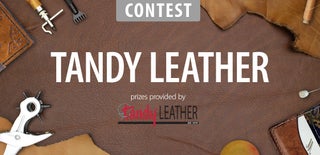Introduction: Leather Spotting Scope!
This is going to be a simple Keplerian telescope of sorts however I intended it more of a spotting scope. Some of you may recognize this as something similar to scope in the great Kevin Costner movie Robin Hood: Prince of Thieves. Well you'd be wrong, that was a terrible movie. But yes, this is similar to the spotting scope that Morgan Freeman's character uses to see the bad guys coming.
Step 1: Science, Science, Science...smaller?
The downside to a simple two lens scope of this sort is that the image is flipped, however you can achieve decent magnification with a small body length. You can fix this with another lens that will right the image. I needed to keep the length of the scope down to 12" (304.8 mm) or less to keep it rigid.
So basically the magnification of the scope is just the ratio of the two lens focal lengths. If your objective lens (the one in front) has a focal length of 12" and your eyepiece has a focal length of 1" then you have roughly 12x magnification. I purchased an objective lens from Amazon that had a diameter of 3.93" (100 mm) with a focal length of 7.87" (200 mm). I found it difficult to find a large enough diameter eyepiece that had a short enough focal length. I did find one that was 1.97" (50 mm) but it had a focal length of 7.87" (200 mm) which would have given me basically no magnification. I finally discovered that glass/crystal sphere's have very short focal lengths so I decided to do the math and figure out how much magnification a spherical eyepiece would get me. The "crystal" sphere i purchase was for decoration and/or juggling so it did not come with a defined focal length and I had to figure it out. The equation for a glass sphere focal length is this FL=(n x D)/(4 x (n-1)), where n is the index of refraction and D is the diameter of the sphere. The index of refraction for basic glass is 1.5. The sphere I bought said in the description that it was lead crystal however it only cost $7.00 so I was skeptical and just figured on it being plain glass. The diameter was 1.97" (50 mm). FL=(1.5 x 50)/(4 x (1.5-1)) = 38.1 mm or 1.5". I of course verified this by actual physical measurement of the focal point with a flashlight and ruler. With my two focal lengths determined my rough magnification was 200/38.1 which works out to 5.25x. Not spectacular, but good enough to be keep moving forward. The distance between the two lenses is now 9.37" (238.1 mm).
Step 2: Proof of Concept
This is a quickly cobbled together proof of concept using scrap leather and tape. There is a great deal of chromatic aberration at the edges which is when the colors get all screwy as the rays of light become separated. This is normal with low quality scopes that don't use lenses to correct for this. The focus is a little off because the distance between the lenses is not exactly at my calculated point. These things aside I was pleased with the results of the test.
Step 3: Preparing Your Leather
The body of the scope is made from 7 - 8 oz veg tanned leather. I laid out the cone shape on a piece of cardboard and cut out a template. Next I laid the template on the leather and traced out the cut. After cutting the leather I drew a simple design and transferred it to the leather with some wax paper and a stylus. I then prepared the leather for tooling.
Step 4: Tooling and Stitching
Tooling the leather takes patience. I tend to get a little manic when I have the opportunity to sit down and work on my projects and that makes me rush through parts that I should be patient with. I had to purposely make myself break the tooling up into short 30 minute periods so that I didn't get sloppy. This took three sessions. After the tooling I cut out and stitched four thin strips of leather that would form channels in which the lenses would be held.
Step 5: Dyeing
There's not much to this step. I chose a pretty dark color. I did coat the moon shape on the picture with a clear sealer first to try and make it stand out. It didn't really work that well. The moon came out looking orange.
Step 6: Straps
Finally I added the straps and buckles. It's a little difficult to buckle the small end because of the tight radius but i just worked the leather a little bit and it worked out.
So there you go. I hope you enjoyed this ible. Please vote for it.

Second Prize in the
Tandy Leather Contest 2016













